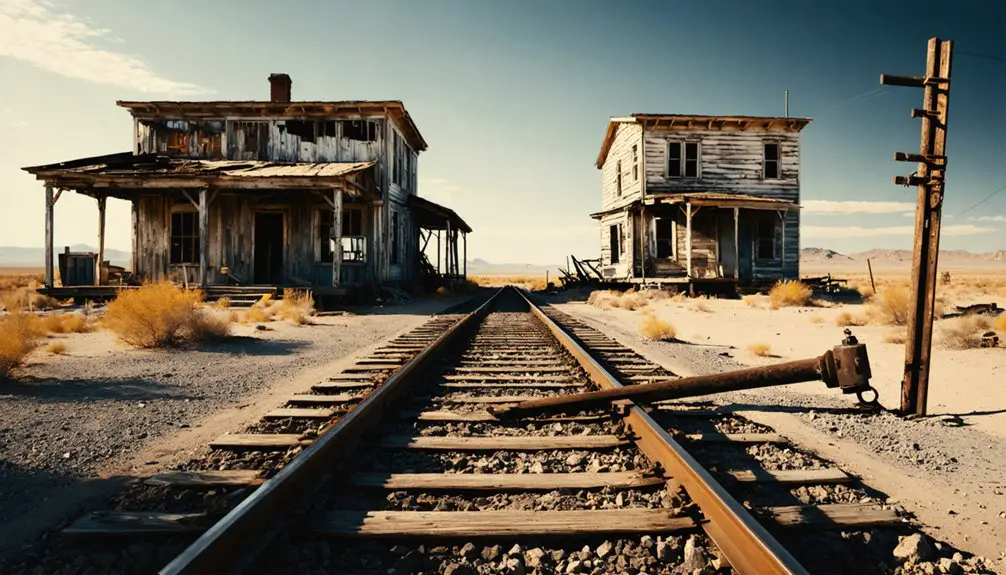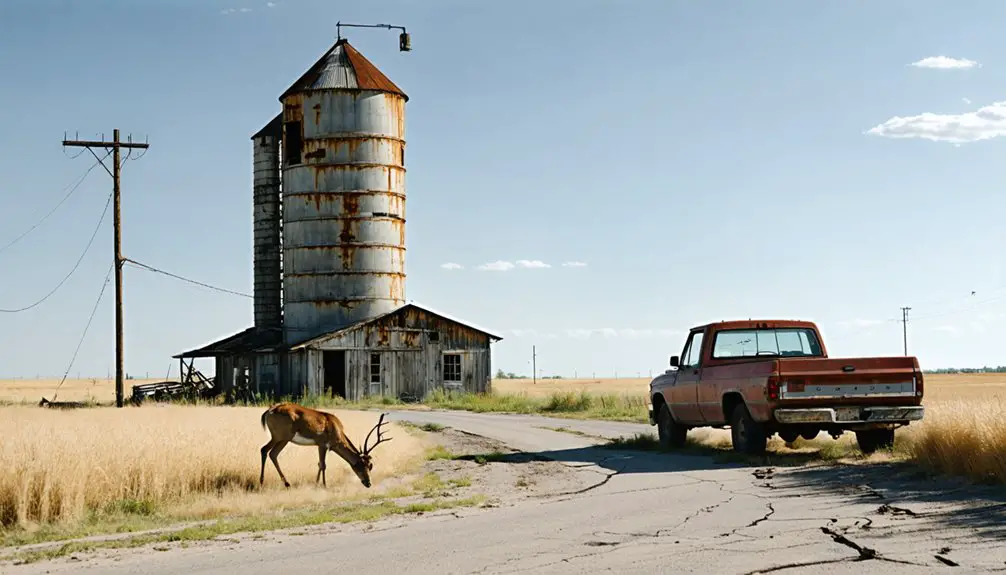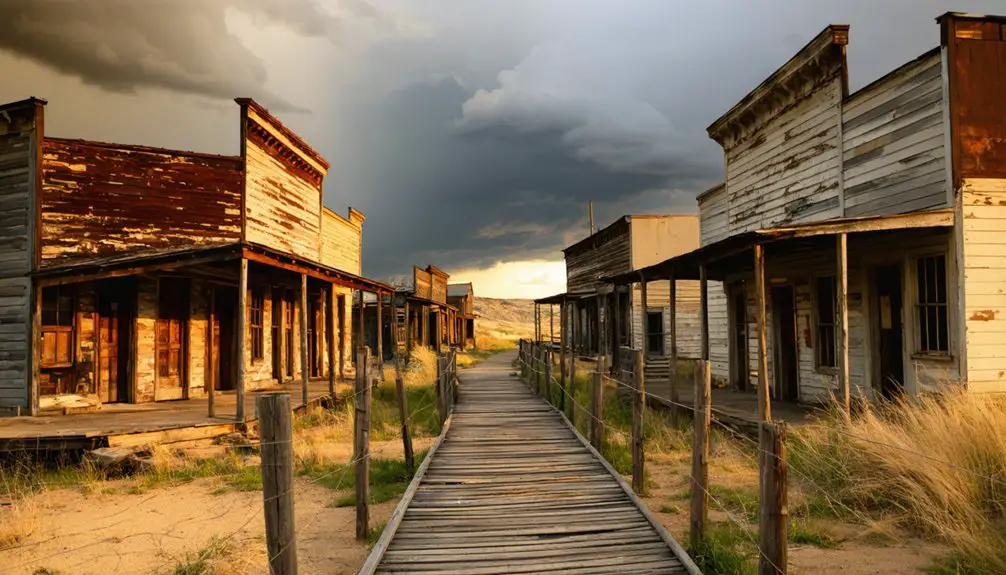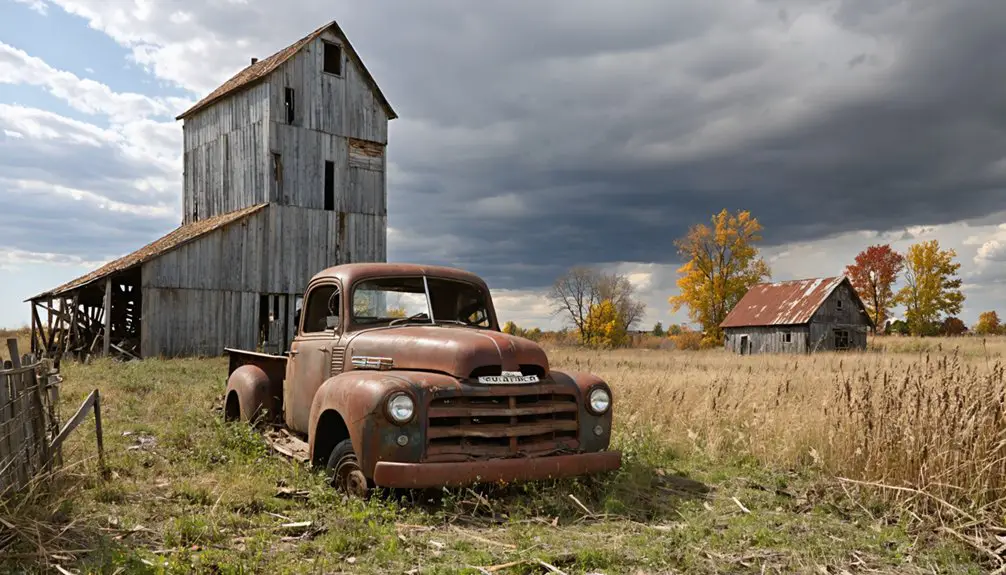You’ll find Hardman, Oregon perched at 3,600 feet elevation, where historic structures from its 1880s origins still stand amid windswept wheat fields. Once a thriving agricultural hub with hotels, stores, and 193 residents at its 1920 peak, this authentic ghost town declined after losing railroad access. Today, 35 year-round residents maintain homes among the preserved buildings, while monthly gatherings at the IOOF Lodge Hall keep frontier traditions alive. The untold stories of Hardman’s past await around every weathered corner.
Key Takeaways
- Hardman is a historic ghost town in Oregon that once thrived as a bustling business center for cattle and wheat industries.
- The town’s decline began when it was bypassed by the railroad in 1920, causing population to drop from 900 to just 20 by 1990.
- Main street formerly featured two hotels, three general stores, and essential services when the population peaked at 193 residents in 1920.
- Located at 3,600 feet elevation, Hardman’s historic structures are preserved and maintained, attracting photographers and history enthusiasts.
- Approximately 35 year-round residents currently live among the historic buildings, with monthly community gatherings held at the IOOF Lodge Hall.
The Rise of a Frontier Settlement
Despite settlement challenges, the region’s 3,600-foot elevation offered ideal conditions for farming and ranching, with fertile soil and abundant fresh air.
Similar to Hardman Peck pianos finding success in unique markets, the area’s strategic isolation actually worked in its favor, as newspapers widely advertised it as prime farming territory and one of Eastern Oregon’s best stock ranges.
Two small settlements, Dairyville (Rawdog) and Adamsville (Yallerdog), merged under David N. Hardman’s leadership when he established the post office in 1881.
By the late 1800s, the town had evolved into a bustling business center for the region’s cattle and wheat industries.
Life in Early Hardman’s Heyday
If you’d visited Hardman during its peak, you’d have found a bustling main street with two hotels, three general stores, and crucial services like a blacksmith shop and barbershop.
The town’s population reached its zenith with 193 residents in 1920. The town’s commercial significance centered around its role as a major shipping point for agricultural products, supported by the region’s premium farmland and stock ranges. David N. Hardman established the town in 1878, laying the foundation for its growth into a thriving Oregon Trail settlement.
Community life flourished at gathering spots like the Odd Fellows Lodge and the local church, where residents connected through regular social events and seasonal celebrations.
Bustling Main Street Life
During its heyday in the late 1800s, Hardman’s main street bustled with a diverse array of commercial establishments and social venues serving over 900 residents.
You’d find three general stores stocking supplies for settlers and travelers, while two hotels provided lodging for weary stagecoach passengers. The town’s main street commerce thrived with a post office, saloon, and barber shop meeting daily needs.
Social interactions centered around the community’s vibrant gathering spots. You could spend evenings at the skating rink, catch races at one of two tracks, or attend events at the meeting halls.
The dance hall drew crowds for entertainment, while multiple churches fostered community bonds. The telephone office kept you connected, making Hardman a crucial hub for both business and pleasure.
Community Gathering Places
As Hardman established itself as a thriving frontier settlement, its community gathering places formed the heart of social life, offering residents diverse venues for recreation, worship, and civic engagement.
You’d find meeting halls bustling with community events, while churches and schools served dual purposes as both educational facilities and social hubs.
For entertainment, you could visit the skating rink, catch races at one of two racetracks, or attend dances at the local dance hall.
The saloon and barber shop provided spaces for casual social interactions, while the general stores served as impromptu gathering spots.
Multiple churches hosted spiritual services and community discussions, creating a tight-knit social fabric that bound residents together through shared experiences and celebrations.
Agricultural Legacy and Economic Growth
You’ll find Hardman’s prime agricultural foundations in its high plateau location, which offered some of the finest farmland and grazing territory in Morrow County during the 1870s settlement period.
The area’s rich, fertile soil proved ideal for wheat production and stock farming, attracting pioneering families like the Royses who established early farming operations and community institutions. The decline of Hardman began when it lost railroad access in 1920.
The town’s agricultural success drove its evolution into a bustling commercial hub by 1900, complete with multiple general stores, hotels, blacksmiths, and mills that processed wheat from farmers across the region.
Prime Farming Territory
While many Oregon ghost towns faded due to depleted mining resources, Hardman’s story began with its exceptional agricultural potential.
You’d find some of Morrow County’s finest farmland here, with rich soil that never failed to produce bountiful harvests. The territory’s natural features supported remarkable crop diversity, from thriving wheat fields to abundant cereal grains.
You’ll appreciate how early settlers maximized the land’s potential through strategic grazing practices. The hills and valleys, initially blanketed with nutritious bunch grass and wild meadow grass, supported thousands of livestock.
At $2.50 per acre, the land attracted pioneers who recognized its value. The region’s marketing as “the greatest stock range in the West” wasn’t mere hype – it genuinely delivered on its promise of agricultural prosperity.
Economic Hub Development
The rich agricultural foundation of Hardman soon transformed the settlement into a bustling economic hub.
You’ll find that timber trade and agricultural innovations drove its prosperity, with the region becoming known for exceptional crop yields and diverse farming operations. The area’s fertile soil produced remarkably large vegetables and potatoes, making it a standout agricultural region. Advanced mechanical grain threshers helped farmers overcome production bottlenecks and increase their output.
As you explore Hardman’s economic peak, you’ll discover these key developments:
- Impressive wheat yields reaching up to 50 bushels per acre, with no recorded crop failures
- Major lumber mills, including Parker’s and Mallory’s operations, serving regional timber demands
- Railroad connections enabling efficient crop marketing and machinery transport
- Integration of mechanized equipment and new farming techniques boosting productivity
The settlement’s strategic location made it a crucial trade center, where agriculture merged with timber processing, creating a dynamic economy supported by livestock operations and mixed farming systems.
Architecture Through the Ages
As two rival settlements merged into what would become Hardman, Oregon, the town’s architectural evolution reflected its frontier origins and eventual decline.
The union of two competing frontier outposts gave birth to Hardman, where weathered buildings chronicle its rise and fall.
You’ll find the earliest structures were modest wooden buildings, including a distinctive jailhouse made of 2×6 lumber and an essential dance hall that served as the social hub. The small community was formed when the villages of Raw Dog and Yellow Dog merged into one settlement.
During its peak, Hardman’s frontier architecture expanded to accommodate over 900 residents. The town featured four hotels, multiple stores, and recreational facilities, all built with locally sourced timber and simple, unadorned facades.
When the railroad bypassed Hardman in the 1920s, the settlement’s evolution took a downturn.
Today, you can still see the weather-worn clapboard buildings and rusted metal elements that tell the story of this once-thriving community, with some structures repurposed for modern community events.
The Railway’s Impact on Town Destiny

Following Heppner’s selection as the railroad’s chosen route in the 1920s, Hardman’s destiny changed forever when tracks bypassed the town by 20 miles. The railroad decisions proved catastrophic for this once-thriving community, triggering a swift economic decline that would transform it into a ghost town.
You’ll find these dramatic changes reflected in Hardman’s transformation:
- Population plummeted from 900 to just 20 residents by 1990
- Local businesses shuttered one by one until the final closure in 1968
- Agricultural producers lost their competitive shipping advantages
- The town’s role as a crucial stagecoach and freight hub became obsolete
The railway’s routing through Heppner shifted the region’s commercial activity northward, leaving Hardman isolated without the essential transportation infrastructure needed to sustain its economy.
This single infrastructure decision effectively sealed the town’s fate. The area’s stark landscape of barren land and hills contributed to its increasing isolation after the railway bypassed the community.
Preserving Historical Landmarks
Despite Hardman’s economic decline following the railroad bypass, preservation efforts have breathed new life into this semi-ghost town’s historical structures.
You’ll find the Town Hall has been refurbished with state funding, while local groups like the Hardman Community Center actively maintain the town’s heritage through events such as the Oyster Feed and Hunters breakfasts.
The historical significance of Hardman’s original clapboard buildings draws photographers and history enthusiasts, creating opportunities for soft tourism that sustains local interest. Artist Charlene Collins captures the town’s essence through her polaroid transfer prints.
Hardman’s preserved clapboard architecture attracts heritage tourists, fostering ongoing community support for these remarkable historic structures.
While the remote location presents preservation challenges, community involvement has been essential in protecting these landmarks.
Through adaptive reuse projects, historic buildings now serve as venues for community activities, ensuring these treasured structures remain both relevant and protected for future generations to explore.
A Day in Modern Hardman

Life in modern Hardman moves at an unhurried pace, where roughly 35 year-round residents navigate unpaved streets and maintain their homes amid the town’s historic wooden structures.
You’ll find a mix of modern activities alongside ghost town tourism, where both locals and visitors embrace the town’s unique character.
Daily life centers around:
- Monthly potluck gatherings at the historic IOOF Lodge Hall
- Informal vehicle repair work and ATV transportation between homes
- Property maintenance and home improvements by year-round residents
- Interactions with curious visitors exploring the ghost town atmosphere
While there aren’t any businesses or city services, you’ll notice well-maintained homes next to weathered buildings, creating a striking contrast between preservation and decay.
The community’s authentic ghost town identity draws tourists while residents maintain their independent, rural lifestyle at 3,600 feet elevation.
Exploring the Surrounding Landscape
The rugged landscape surrounding Hardman tells its own compelling story at 3,600 feet elevation.
At 3,600 feet above sea level, Hardman’s untamed terrain whispers tales of resilience through its rugged features.
You’ll find yourself amid expansive wheat fields and sagebrush plains, where wild sunflowers paint the terrain in vibrant colors from May through August – perfect for landscape photography enthusiasts.
As you explore, you’ll discover ponderosa pine groves scattered across the plateau, while Rock Creek carves its path northwest toward the Columbia River.
The area’s abundant wildlife observation opportunities include native species adapting to both natural habitats and abandoned structures.
You’re free to roam the well-maintained Sunflower Flat Road, which leads to spectacular sites like the John Day Fossil Beds and Cottonwood Canyon State Park, where painted hills and Cathedral Rock showcase the region’s dramatic geological features.
Photography and Tourism Opportunities

Photographers seeking authentic ghost town imagery will find rich opportunities throughout Hardman’s historic landscape. Your photography techniques can capture the essence of the American frontier through the IOOF Lodge Hall, original clapboard buildings, and weathered town structures against the dramatic Blue Mountain backdrop.
Optimize your tourism strategies by planning around these key features:
- Historic architecture with authentic period details, including abandoned vehicles and ranch equipment
- High plateau location offering dramatic lighting conditions at 3,600 feet elevation
- Seasonal events like the October Oyster Feed for capturing living history
- Natural framing opportunities with surrounding wheat fields and sagebrush
You’ll find the best access via Oregon Route 207, about 20 miles southwest of Heppner.
Remember to check weather conditions, as the remote location requires careful planning for the most successful shoots.
Frequently Asked Questions
Are There Any Ghost Stories or Paranormal Activities Reported in Hardman?
You won’t find documented ghost sightings or paranormal investigations in historical records. While the town’s abandoned buildings create an eerie atmosphere, there’s no verified evidence of supernatural activity here.
What Happened to the Original Residents and Their Descendants?
Like leaves scattered by autumn winds, the original residents and their family descendants drifted away to larger towns when the railroad bypassed Hardman, seeking better economic opportunities elsewhere.
Is Camping Allowed Within the Ghost Town Limits?
No, you can’t camp within the town limits. Oregon Administrative Rule 736-030-0020 prohibits overnight camping in these areas, and there aren’t any designated camping spots or ghost town amenities available.
Can Visitors Enter and Explore the Abandoned Buildings?
You shouldn’t enter abandoned buildings – they’re privately owned and dangerous. Focus on exterior historical preservation through photography and respectful exploration from safe distances to avoid legal issues and safety hazards.
What Are the Winter Road Conditions for Accessing Hardman?
Like traversing the wild frontier, you’ll face challenging winter access. SH 207’s narrow mountain roads receive basic maintenance, but you’ll need chains and winter safety gear for unpredictable snow and ice conditions.
References
- https://www.youtube.com/watch?v=nAidjKAtGUw
- https://www.ghosttowngallery.com/htme/hardman.htm
- https://en.wikipedia.org/wiki/Hardman
- https://eastoregonian.com/2019/04/11/ghosts-of-eastern-oregon/
- https://ermakvagus.com/North America/usa/West/Hardman/Hardman.htm
- https://traveloregon.com/things-to-do/culture-history/ghost-towns/secrets-oregons-ghost-towns/
- https://thedyrt.com/magazine/local/old-west-ghost-towns-in-oregon/
- https://eugeneweekly.com/2017/10/26/ghosting-oregon/
- https://www.ghosttowngallery.com/ghostsor/Hardman_History.doc
- https://afterthepurge.net/2025/05/21/meandering-on-the-way-may-16-to-21-2025/



